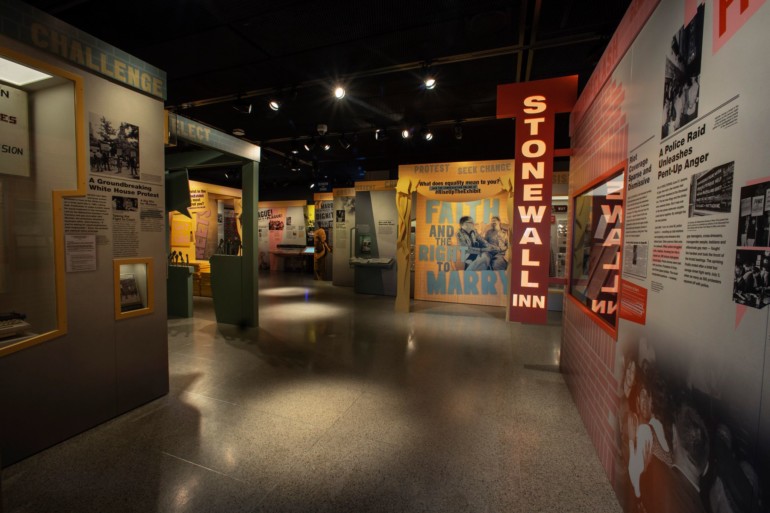The Illinois Holocaust Museum & Education Center is hosting a groundbreaking new exhibit, Rise Up: Stonewall and the LGBTQ Rights Movement, which explores the struggle for LGBTQ rights over the past 50-plus years.
The show, which begins on Oct. 17 and runs through May 8, is very much in keeping with the mission of the museum, which is not only dedicated to informing people about the Holocaust, but also calls on the public to take action when human rights are violated. “We’re a Holocaust history museum, but we also look at social justice and human rights issues,” says Arielle Weininger, Chief Curator of Collections and Exhibitions. “There is a significant population (of LGBTQ people) in our country and around the world who have been denied certain basic rights for large periods of time, and who are still working to obtain those rights.”
The exhibit, sponsored by the Elizabeth Morse Genius Charitable Trust and the Abe & Ida Cooper Foundation, takes visitors on an immersive and inspiring journey that weaves together moving narratives of gay rights history and the on-going fight for civil rights, showing how activists changed the world. “Different activists used First Amendment rights — freedom of speech, press, assembly, religion and petition — to advocate for change in society to achieve the huge gains that we have today,” Weininger says. While great strides have been made, the fight is not over. “It is important to know that although many of these rights have been won, they are still being questioned by some groups. We must remain vigilant so that everyone in our society has equality and legal protections,” she says.
Rise Up covers the history of gay rights from the 1950s through to the present, including the Stonewall Uprising, which was a pivotal moment in the struggle. “Stonewall, an uprising in 1969 at a gay bar in New York City, propelled forward the modern LGBTQ rights movement,” Weininger says.
The exhibit also examines how popular culture has influenced and reflected attitudes about the LGBTQ community through film, television, sports, and music. It delves into how the gay rights movement harnessed the power of public protest and demonstration to change laws and shatter stereotypes.
Other major points about gay rights history the exhibit covers includes the 1978 assassination of Harvey Milk, one of the country’s first openly gay elected officials; the AIDS crisis; U.S. Representative Barney Frank’s public coming out in 1987; the efforts to support hate crime legislation; the implementation and later repeal of “Don’t Ask, Don’t Tell”; and the fight for marriage equality.
These historic events are brought to life with more than 80 artifacts, such as posters from Milk’s campaign for Mayor of San Francisco; an original rainbow flag designed by its creator Gilbert Baker; the gavel that Speaker of the House Nancy Pelosi used to announce the repeal of “Don’t Ask, Don’t Tell”; and interactive kiosks with information on LGBTQ rights issues. It also features three original films.
Weininger says that the exhibit poses questions that are designed to spark thought and conversation. “We always say we don’t want to just to teach history, we want people to feel compelled to take action to change society based on information they’ve learned here,” she says. “This show matches the way our museum approaches everything we do.”
The curator also notes that the exhibit is emblazoned with words that are designed to inspire action and give hope. “One of the things I really like are the words that are on exhibit itself,” she says. “They are large words that convey the message of the show, which clearly talks about discrimination, prejudice and things that are not right in society. But what this exhibit truly highlights are the actions taken to change society. So, words like ‘organize,’ ‘unite,’ ‘elect,’ ‘confront,’ ‘speak’ and ‘listen’ are highlighted.”
Kelley Szany, Vice President of Education and Exhibitions, agrees that the exhibit reflects the Museum’s mission and gives hope for a brighter future with less discrimination. “Rise Up affirms the Museum’s continued commitment to bringing forth exhibitions that address human rights and social justice issues,” she says. “It creates a space for discussion and gives our visitors the tools they need to take a stand.”
While Milk and Frank may be well known in the struggle for gay rights, the exhibit also covers the work of others who are not recognized as widely, such as Marsha P. Johnson, a founder of the Gay Liberation Front and an outspoken activist. There’s also Frank Kameny, an advocate who was motivated to fight for gay rights after being dismissed in the 1950s from his job at the U.S. Army’s Army Map Service because he was gay.
Weininger adds that the exhibit shows how ordinary Americans changed the world through their actions. “This exhibit really honors some of the people who were at the forefront, who put themselves, their families, and their careers at great risk to come out and fight for what they knew was right,” Weininger says.
To support this exhibition and bring others like it to Chicagoland, please a consider a donation to the Museum.
The Illinois History Museum & Education Center honors the survivors and victims of the Holocaust and transforms history into current, relevant, and universal lessons in humanity.
The Museum is located at 9693 Woods Drive, Skokie. It is open Wednesday through Sunday from 10 a.m. through 5 p.m. For more information, call 847-967-4800, email info@ilhmec.org or visit www.ilholocaustmuseum.org.

